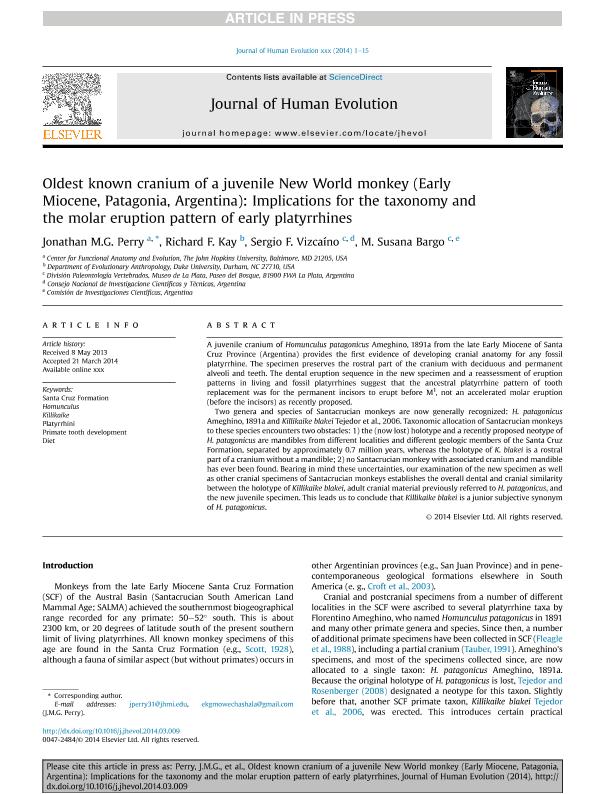Mostrar el registro sencillo del ítem
dc.contributor.author
Perry, Jonathan M. G.
dc.contributor.author
Kay, Richard F.
dc.contributor.author
Vizcaíno, Sergio Fabián

dc.contributor.author
Bargo, María Susana

dc.date.available
2017-12-20T20:54:00Z
dc.date.issued
2014-03
dc.identifier.citation
Bargo, María Susana; Vizcaíno, Sergio Fabián; Kay, Richard F.; Perry, Jonathan M. G.; Oldest known cranium of a juvenile New World monkey (Early Miocene, Patagonia, Argentina): implications for the taxonomy, and the molar eruption pattern of early platyrrhines; Elsevier; Journal Of Human Evolution; 74; 3-2014; 67-81
dc.identifier.issn
0047-2484
dc.identifier.uri
http://hdl.handle.net/11336/31174
dc.description.abstract
A juvenile cranium of Homunculus patagonicus Ameghino, 1891a from the late Early Miocene of Santa Cruz Province (Argentina) provides the first evidence of developing cranial anatomy for any fossil platyrrhine. The specimen preserves the rostral part of the cranium with deciduous and permanent alveoli and teeth. The dental eruption sequence in the new specimen and a reassessment of eruption patterns in living and fossil platyrrhines suggest that the ancestral platyrrhine pattern of toothreplacement was for the permanent incisors to erupt before M1, not an accelerated molar eruption (before the incisors) as recently proposed.Two genera and species of Santacrucian monkeys are now generally recognized: H. patagonicus Ameghino, 1891a and Killikaike blakei Tejedor et al., 2006. Taxonomic allocation of Santacrucian monkeys to these species encounters two obstacles: 1) the (now lost) holotype and a recently proposed neotype of H. patagonicus are mandibles from different localities and different geologic members of the Santa Cruz Formation, separated by approximately 0.7 million years, whereas the holotype of K. blakei is a rostral part of a cranium without a mandible; 2) no Santacrucian monkey with associated cranium and mandible has ever been found. Bearing in mind these uncertainties, our examination of the new specimen as well as other cranial specimens of Santacrucian monkeys establishes the overall dental and cranial similarity between the holotype of Killikaike blakei, adult cranial material previously referred to H. patagonicus, and the new juvenile specimen. This leads us to conclude that Killikaike blakei is a junior subjective synonym of H. patagonicus.
dc.format
application/pdf
dc.language.iso
eng
dc.publisher
Elsevier

dc.rights
info:eu-repo/semantics/openAccess
dc.rights.uri
https://creativecommons.org/licenses/by-nc-nd/2.5/ar/
dc.subject
Santa Cruz Formation
dc.subject
Homunculus
dc.subject
Killikaike
dc.subject
Platyrrhini
dc.subject.classification
Meteorología y Ciencias Atmosféricas

dc.subject.classification
Ciencias de la Tierra y relacionadas con el Medio Ambiente

dc.subject.classification
CIENCIAS NATURALES Y EXACTAS

dc.title
Oldest known cranium of a juvenile New World monkey (Early Miocene, Patagonia, Argentina): implications for the taxonomy, and the molar eruption pattern of early platyrrhines
dc.type
info:eu-repo/semantics/article
dc.type
info:ar-repo/semantics/artículo
dc.type
info:eu-repo/semantics/publishedVersion
dc.date.updated
2017-12-12T18:25:07Z
dc.journal.volume
74
dc.journal.pagination
67-81
dc.journal.pais
Países Bajos

dc.journal.ciudad
Amsterdam
dc.description.fil
Fil: Perry, Jonathan M. G.. University Johns Hopkins; Estados Unidos
dc.description.fil
Fil: Kay, Richard F.. University of Duke; Estados Unidos
dc.description.fil
Fil: Vizcaíno, Sergio Fabián. Universidad Nacional de la Plata. Facultad de Ciencias Naturales y Museo. División Paleontología Vertebrados; Argentina. Consejo Nacional de Investigaciones Científicas y Técnicas. Centro Científico Tecnológico Conicet - La Plata; Argentina
dc.description.fil
Fil: Bargo, María Susana. Universidad Nacional de la Plata. Facultad de Ciencias Naturales y Museo. División Paleontología Vertebrados; Argentina. Provincia de Buenos Aires. Gobernación. Comisión de Investigaciones Científicas; Argentina
dc.journal.title
Journal Of Human Evolution

dc.relation.alternativeid
info:eu-repo/semantics/altIdentifier/url/http://www.sciencedirect.com/science/article/pii/S0047248414001560
dc.relation.alternativeid
info:eu-repo/semantics/altIdentifier/doi/http://dx.doi.org/10.1016/j.jhevol.2014.03.009
Archivos asociados
